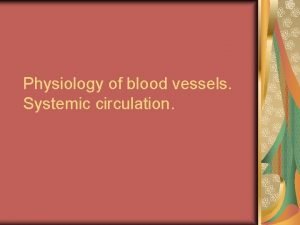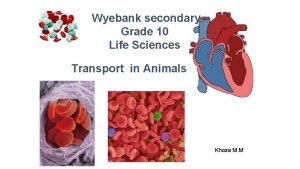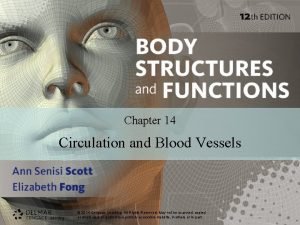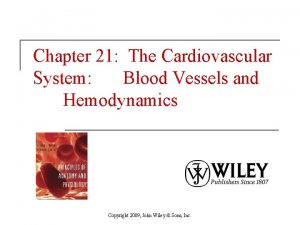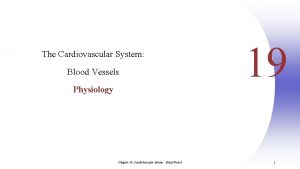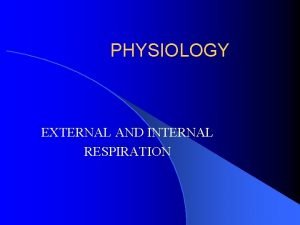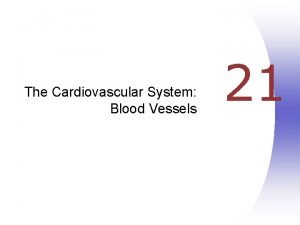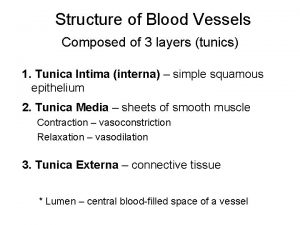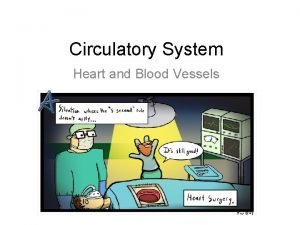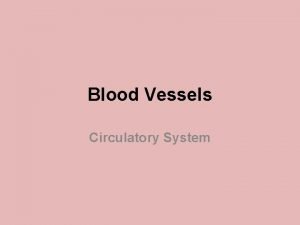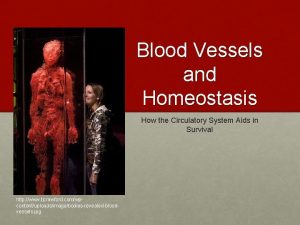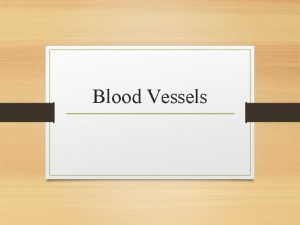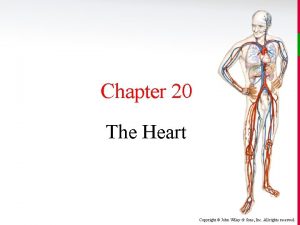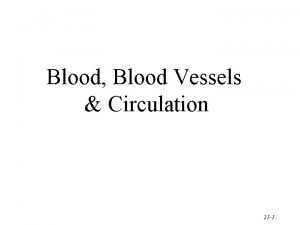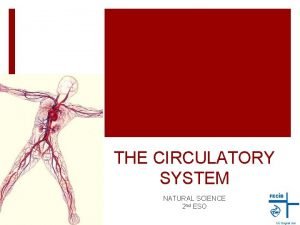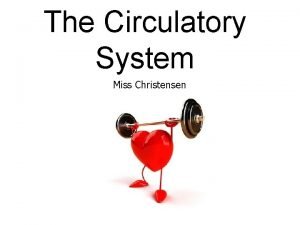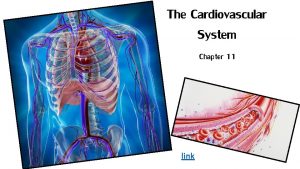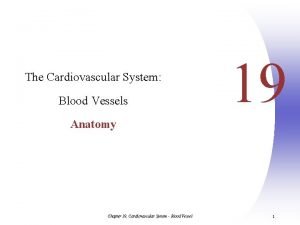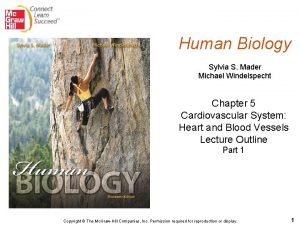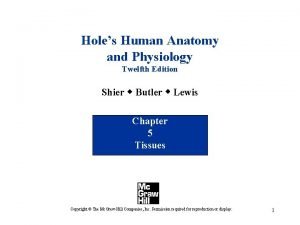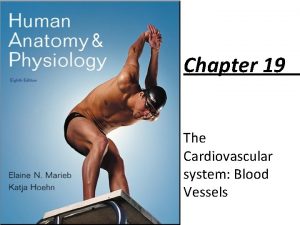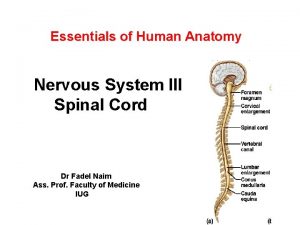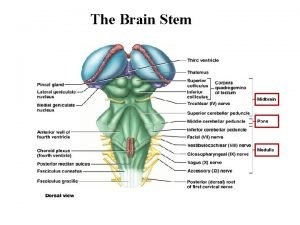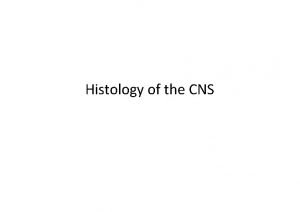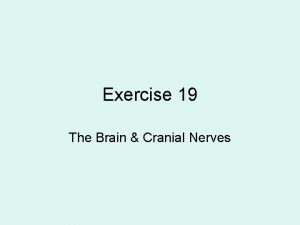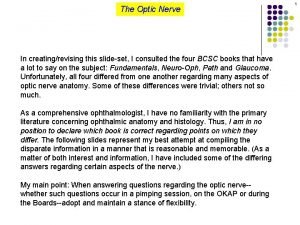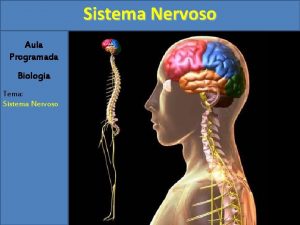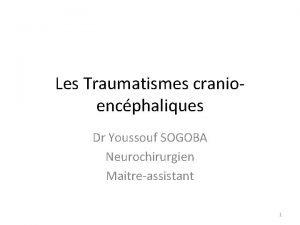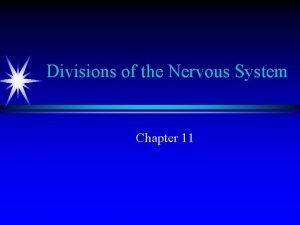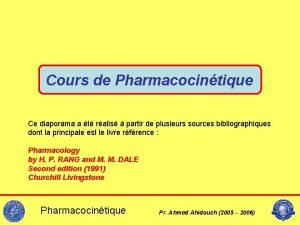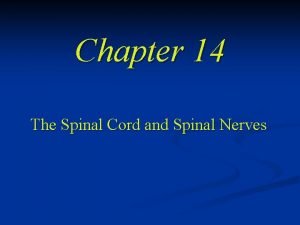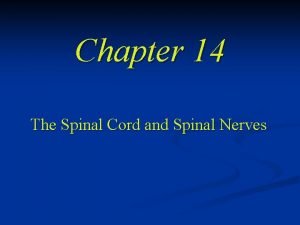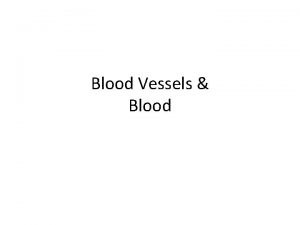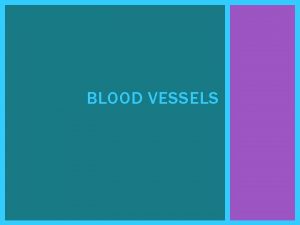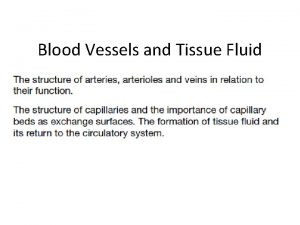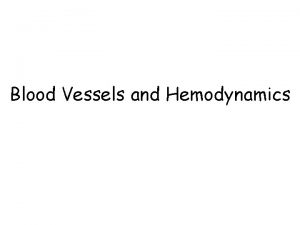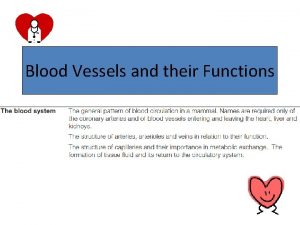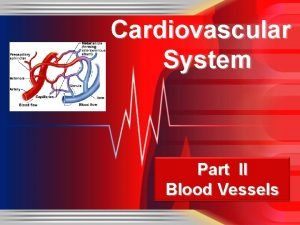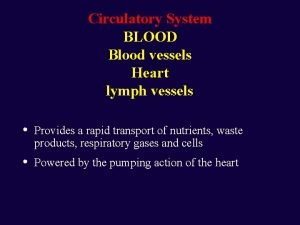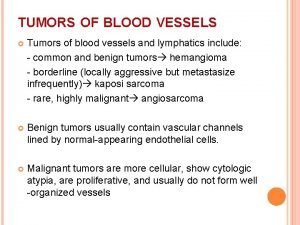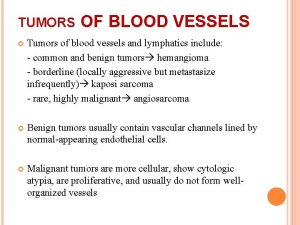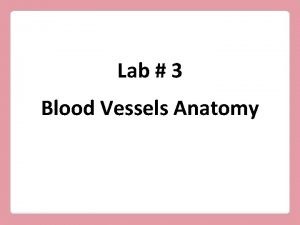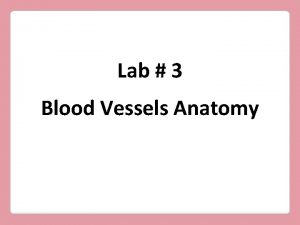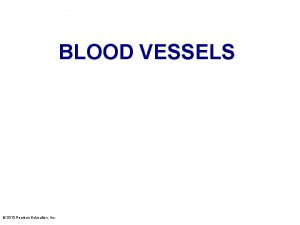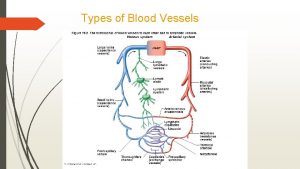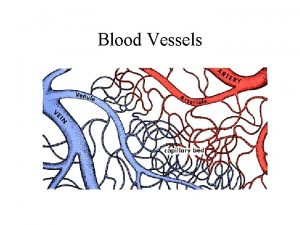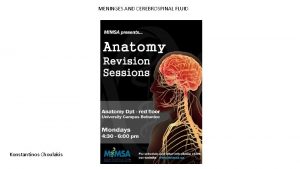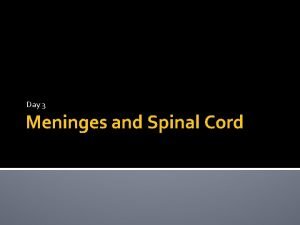The Meninges and Blood Vessels of Brain and

The Meninges and Blood Vessels of Brain and Spinal Cord, and the Cerebrospinal Fluid SHANDONG UNIVERSITY Liu Zhiyu

Meninges of Brain and Spinal Cord n n The spinal cord and brain are surrounded by three membranes, the meninges. Named from the outside inward they are q q q Dura mater Arachnoid mater Pia mater

The Meninges of Spinal Cord n n n Spinal dura mater Spinal arachnoid mater Spinal pia mater

Spinal Dura Mater Characters n n A dense, fibrous membrane that encloses the spinal cord and cauda equina Above, attached to circumference of foramen magnum Below, becomes thinner at level of S 2, invests filum terminale to attach at back of coccyx On each side, continuous with external membrane of spinal nerves at intervertebral foramina

Spinal Dura Mater n Epidural space q q n Position: lies between spinal dura mater and periosteum of vertebral canal Contents: a quantity of loose connective tissue, fat, lymphatic vessels and vertebral venous plexus, the spinal nerves on each side pass through the epidural space which is applicable for block anesthesia Subdural space

Spinal Arachnoid Mater Characters n n A thin, delicate, tubular membran loosely investing spinal cord Above, it is continuous with cerebral arachnoid mater

Subarachnoid Space n n Position: lies between pia and arachnoid maters containing cerebrospinal fluid Terminal cistern: the largest part of subarachnoid space extending from termination of spinal cord to level of S 2, where it is occupied by nerves of cauda equina, so it is the best site for a lumbar puncture

Lumbar spinal puncture (spinal tap)

Spinal Pia Mater n n n A delicate vascular membrane that closely invests the spinal cord Denticulate ligament: consist of 21 pairs triangular ligaments extending from spinal cord on each side between anterior and posterior roots of spinal nerves to spinal dura mate; these ligaments help to fix position of spinal cord. Filum terminale: an extension of pia beyond conus medullaris


The Meninges of Brain n Cerebral dural mater n Cerebral arachnoid mater n Cerebral pia mater

Cerebral Dural Mater Characters n n A thick and dense inelastic membrane that composed of two layers, an inner or meningeal and outer or endosteal It is in loose contact with calvaria, and most strongly adherent to base of skull

Cerebral dural mater Four septa n n Cerebral falx Tentorium of cerebellum - in front there is a gap, the tentorial incisure, for passage of midbrain Cerebellar falx Diaphragma sellae

Cerebral Dural Mater Sinuses of duramater n n Superior sagittal sinus Inferior sagittal sinus Straight sinus Confluence of sinus

Cerebral Dural Mater n Transverse sinus n Sigmoid sinus n Superior petrosal sinuses n inferior petrosal sinuses

Cerebral Dural Mater Cavernous sinus n Position: lies on each side of sella turcica n Traversing the cavernous sinus q q n Internal carotid artery Abducent nerve Traversing the lateral wall of the cavernous sinus q q Oculomotor nerve Trochlear nerve Ophthalmic nerve Maxillary nerve

Cerebral Dural Mater

The flowing of the blood in dural sinus Sup. sagittal sinus Inf. sagittal sinus Straight sinus Confluence of sinus Transverse sinus Sup. petrosal sinus Sigmoid sinus Cavernous sinus Inf. petrosal sinus Internal jugular vein

Cerebral Arachnoid Mater n Characters: a delicate membrane covering brain loosely, passing over sulci and entering only cerebral longitudinal and transverse fissures

Cerebral Arachnoid Mater n Arachnoid granulations - project into sinuses of dura mater, serve as sites where cerebrospinal fluid diffuses into bloodstream

Subarachnoid Cisterns n n n Cerebellomedullary cistern Chiasmatic cistern Interpeduncular cistern Pontine cistern Superior cistern

Cerebellomedullary cistern

Intracranial hemorrhages… ÿ Extradural or epidural hemorrhage: blood collects between the calvaria and the periosteal layer of dura

Intracranial hemorrhages… ÿ Subdural hematoma: blood collects between the dura and arachnoid

Intracranial hemorrhages ÿ Subarachnoid hemorrhage: blood flows into the subarachnoid space and mixes with cerebrospinal fluid

Cerebral Pia Mater n n Closely invests brain surface In some areas the pia invaginates into ventricles to take part in the formation of choroids plexus

Circulation of Cerebrospinal Fluid (CSF) n n n Cerebrospinal fluid is a clear colorless fluid Nourishes brain Removes waste Conducts chemical signals between parts of CNS Liquid cushion for brain and spinal cord Production: produced by the choroids plexuses within the lateral, third and fourth ventricles

Choroid plexus = choroidal epithelium surrounding brain capillaries CSF volume = 150 ml 75 ml in cisterns 50 ml in subarachnoid space 25 ml in ventricles CSF formation = 450 -600 ml/day

Circulation of Cerebrospinal Fluid (CSF) CSF drains from lateral ventricle mesencephalic aqueduct interventricular foramina fourth ventricle third ventricle median and two lateral apertures subarachnoid space arachnoid granulations superior sagittal sinus vein

Hydrocephalus

Hydrocephalus

Arteries of Brain Two sources n n Internal carotid artery: supplies anterior 2/3 of cerebral hemisphere and parts of diencephalon Vertebral artery: supplies postterior 1/3 of cerebral hemisphere and parts of diencephalon, brain stem and cerebellum

Internal Carotid Artery Branches n n Anterior cerebral artery Middle cerebral artery Anterior choroidal artery Posterior communicating artery

Internal Carotid Artery Anterior cerebral artery n n Joined the fellow of the opposite side by the anterior communicating artery Cortical branches: supply all medial surface of the cerebral cortex as far back as the parietooccipital sulcus and superior border of the suprolateral surface of the cerebral hemisphere Central branches: supply caudate nucleus, anterior part of lentiform nucleus and anterior limb of internal capsule

Internal Carotid Artery Middle cerebral artery n Cortical branches: supply most of superolateral surface of cerebral hemisphere and insular lobe n Central branches: supply lentiform and caudate nuclei, genu and posterior limb of internal capsule (lenticulostriate artery)

Internal Carotid Artery n Anterior choroidial artery: passes backward, enters inferior horn of lateral ventricle, and ends in choroid plexus. It supplies lateral geniculate body, posterior limb of internal capsule, middle 3/5 of crus cerebri and globus pallidus n Posterior communicating artery: runs backward to join posterior cerebral artery

Vertebral Artery n Cranial branches q q n Anterior and posterior spinal arteries Posterior inferior cerebellar artery Branches of basilar artery q q q Anterior inferior cerebral artery Labyrinthine artery Pontine arteries Superior cerebellar artery Posterior cerebral artery

Vertebral Artery Posterior cerebral artery n n Cortical branches: supply medial and inferior surfaces of temporal lobe and occipital lobe Central branches: supply dorsal thalamus, medial geniculate body, hypothalamus and subthalamus

Cerebral Arterial Circle ( Circle of Willis ) Formation n n Anterior communicating artery Both anterior cerebral arteries Internal carotid arteries Posterior communicating arteries Posterior cerebral arteries Position: lies on sella turcica around optic chiasma, tuber cinereum and mamillary bodies

Microaneurysm Lenticulostriate arteries Subarachnoid hemorrhage

Veins of Brain Superficial cerebral veins n n n Drain blood from cortex and subcortical medullary substance and empty into adjacent sinuses of dura mater Superior cerebral v. ascend over the lateral surface of the cerebral hemisphere and drain into the superior sagital sinus. Inferior cerebral v. drain into the. transverse sinus and cavernous sinus Superficial middle cerebral v. drains the lateral surface of the cerebral hemisphere. it empties into the cavenous sinus. Deep middle cerebral v. drains insula and is joined by the anterior cerebral and striate veins to form the basal vein.

Veins of Brain Deep cerebral veins n n Drain deeper parts of hemispheres, basal nuclei, internal capsule diencephalon and choroid plexus Ultimately form great cerebral vein which enter straight sinus

Arteries of Spinal Cord n Two sources q q n n Anterior and posterior spinal arteries Branches of segmental arteries: radicular arteries of posterior intercostals arteries, lumbar arteries, and lateral sacral arteries Damage area: T 1~T 4, ventral part of L 1 vascular ring ( vasocorona )

Arteries of Spinal Cord Posterior spinal a. Vascular ring Anterior spinal a. Radicular a.
- Slides: 44
